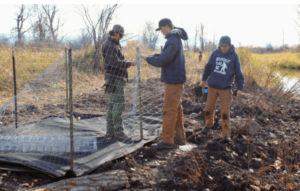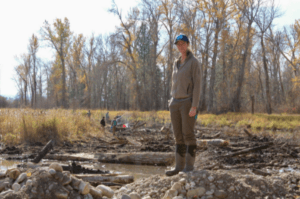
by Michael Howell
Bitterroot Trout Unlimited is getting a helping hand from students at the Trapper Creek Job Corps Civilian Conservation Center in their ongoing restoration work at North Burnt Fork Creek on the Lee Metcalf National Wildlife Refuge. The restoration work is associated with a fish passage project initiated by Montana Trout Unlimited in cooperation with the US Fish and Wildlife Service involving the replacement of a culvert that has blocked fish passage from the river into North Burnt Fork Creek for over 50 years. Bitterroot Trout Unlimited was instrumental in extending the fish passage project into a broader stream restoration project stretching over half a mile upstream from the culvert.
The restoration work includes removal of a lot of Reed Canary Grass, an invasive species that has taken over long stretches of the stream bank and floodplain along the lower portion of North Burnt Fork Creek, and replacing it with shrubs and willows. According to Trout Unlimited’s Special Project Manager Christine Brissette, the domination of the area by the aggressive Reed Canary Grass not only reduces stream bank stability it also reduces habitat more preferable for waterfowl and migrating songbirds.
The plan involves replacing much of the grass with locally sourced shrubs and willows. The shrubs are coming from Great Bear Native Plants in Hamilton and the willows are coming primarily from cuttings taken from Skalkaho Bend Park in Hamilton. Bitterroot TU president Dave Ward succeeded in getting permission from the Hamilton City Council to harvest the willow cuttings from the park and student volunteers from Trapper Creek Job Corps and the Corvallis High School’s Classroom Without Walls program did the cutting. Over 2,000 willow cuttings were harvested from the park.

Brissettte said that willow cuttings purchased from a private contractor cost about $1.25 each. “Thanks to the City’s cooperation and the help from these student volunteers we have saved about $2,500 in project expenses,” said Brissette.
The help from Trapper Creek Job Corps students goes beyond providing cut willows. They are also involved in planting them along the stream bank as well as in building the “exclusion” fencing that will help protect the young willows and shrubs from being decimated by beavers and deer before they can mature.
Forestry Conservation and Firefighting instructor at the Job Corps, Scott Aronson, said that when Trout Unlimited approached them about helping out in the project they jumped at the chance. He said the Job Corps offers students hands-on experience in many areas of work including construction, hospitality, manufacturing, and renewable resources and energy. He said this project was a good fit for the students in his Forestry Conservation and Firefighting program.
One of the student volunteers working on the project, Mason Quest from Billings, Montana, said he would like to get it out there that the Job Corps is a great place to go if you are feeling kind of stuck in life and don’t know where to go or what to do.
“Since I came to the Job Corps my life has completely changed,” said Quest. “I feel like I have a purpose in life, getting out and doing things that I’ve never done before, working on things like this natural resource project, helping the community and helping the environment. It’s been an amazing opportunity.” He said he has been with the Job Corps for six months now and will continue for another seven months. After that he hopes to work as a wilderness ranger in Yellowstone National Park “or any other park that may have opportunities,” he said.
Brissette said that she enjoys working with local businesses on her projects and feels lucky to have Timberland Excavating on the job. Owner of the business, Jake Watts, said that Timberlands Excavating started out in 2017 chasing timber sales around west central Montana and northern Idaho but has shifted over into restoration work in recent years.
Besides the primary work involved in removing the old culvert, which blocked fished passage from the river into the creek, and installing a new fish-friendly bottomless culvert which leaves the stream uninterrupted, they are working extensively on the removal of the Reed Canary Grass and restoring the stream bank and associated wetlands for miles upstream. This involves digging trenches to plant rows of willow cuttings and importing a large quantity of woody debris and old bed rock. According to Watts, the restored stream bank will include associated floodplains of varying depths creating good habitat for amphibians, waterfowl and songbirds.
“These guys just came onto our radar in the last five years or so in terms of stream restoration work,” said Brissette. “They are super-efficient and flexible, good trouble shooters and have a good eye for what rivers and streams and floodplains are supposed to look like.”
Lee Metcalf National Wildlife Refuge Manager Tom Reed said, “This is a project that has been on our books for a long time, but because of the size of our staff and funding we probably wouldn’t have gotten to it. So, it’s been very positive to move forward with it and to move forward at the rate we are.” He said that because the stream restoration was taking place in the Refuge’s Wildlife Viewing Area that gets hundreds of thousands of visitors annually, the interpretative signing and stream restoration work associated with the culvert work will greatly enhance the public’s wildlife viewing opportunities.
“The partnership with the Refuge on this project has been a great opportunity for us as well,” said Brissette. “Not only do we know that the work we have engaged in is going to be protected long term, but it also opens up a lot more opportunity for public engagement.”
The project is ongoing and, according to Brissette, there is still an opportunity for the general public to be involved. Anyone interested in volunteering can sign up by contacting Bitterroot Trout Unlimited on its web site at www.bitterroottu.org.